Microsoft 70-461 Querying Microsoft SQL Server 2012 Online Training
Microsoft 70-461 Online Training
The questions for 70-461 were last updated at Dec 24,2025.
- Exam Code: 70-461
- Exam Name: Querying Microsoft SQL Server 2012
- Certification Provider: Microsoft
- Latest update: Dec 24,2025
You develop a Microsoft SQL Server 2012 database that contains a heap named OrdersHistorical.
You write the following Transact-SQL query:
– INSERT INTO OrdersHistorical
– SELECT * FROM CompletedOrders
You need to optimize transaction logging and locking for the statement.
Which table hint should you use?
- A . HOLDLOCK
- B . ROWLOCK
- C . XLOCK
- D . UPDLOCK
- E . TABLOCK
You use a Microsoft SQL Server 2012 database that contains two tables named SalesOrderHeader and SalesOrderDetail.
The indexes on the tables are as shown in the exhibit. (Click the Exhibit button.)
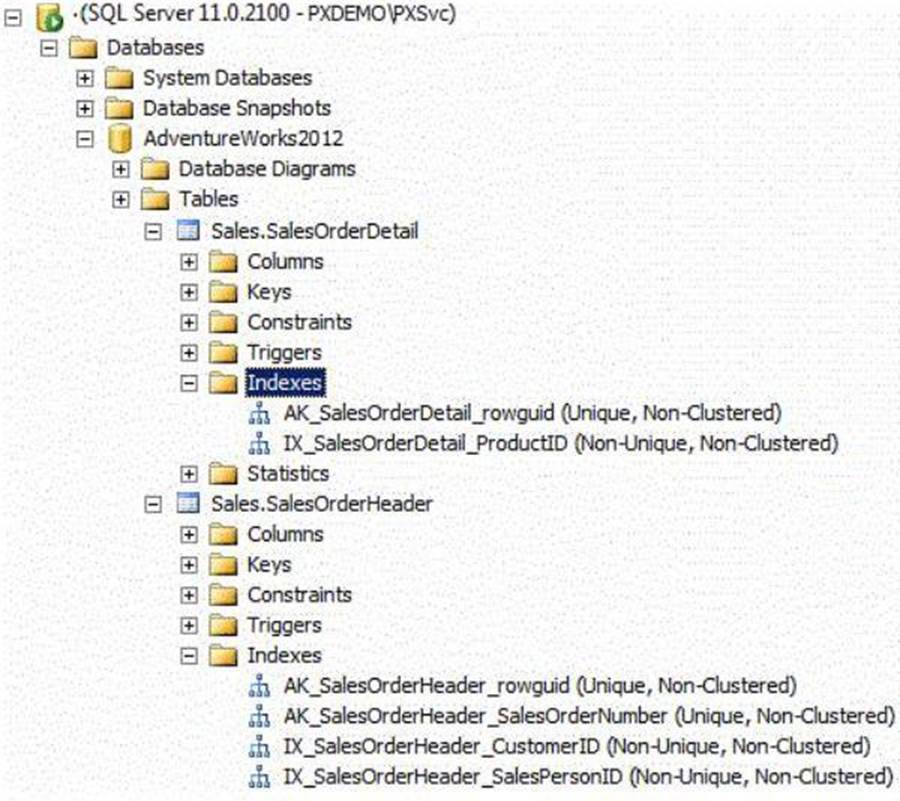
You write the following Transact-SQL query:
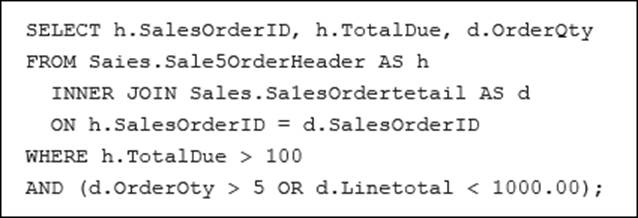
You discover that the performance of the query is slow. Analysis of the query plan shows table scans where the estimated rows do not match the actual rows for SalesOrderHeader by using an unexpected index on SalesOrderDetail.
You need to improve the performance of the query.
What should you do?
- A . Use a FORCESCAN hint in the query.
- B . Add a clustered index on SalesOrderId in SalesOrderHeader.
- C . Use a FORCESEEK hint in the query.
- D . Update statistics on SalesOrderId on both tables.
Your database contains a table named Purchases. The table includes a DATETIME column named PurchaseTime that stores the date and time each purchase is made. There is a non-clustered index on the PurchaseTime column.
The business team wants a report that displays the total number of purchases made on the current day.
You need to write a query that will return the correct results in the most efficient manner.
Which Transact-SQL query should you use?
- A . SELECT COUNT(*)
FROM Purchases
WHERE PurchaseTime = CONVERT(DATE, GETDATE()) - B . SELECT COUNT(*)
FROM Purchases
WHERE PurchaseTime = GETDATE() - C . SELECT COUNT(*)
FROM Purchases
WHERE CONVERT(VARCHAR, PurchaseTime, 112) = CONVERT(VARCHAR, GETDATE(), 112) - D . SELECT COUNT(*)
FROM Purchases
WHERE PurchaseTime >= CONVERT(DATE, GETDATE())
AND PurchaseTime < DATEADD(DAY, 1, CONVERT(DATE, GETDATE()))
You develop a database for a travel application. You need to design tables and other database objects.
You need to store media files in several tables.
Each media file is less than 1 MB in size. The media files will require fast access and will be retrieved frequently.
What should you do?
- A . Use the CAST function.
- B . Use the DATE data type.
- C . Use the FORMAT function.
- D . Use an appropriate collation.
- E . Use a user-defined table type.
- F . Use the VARBINARY data type.
- G . Use the DATETIME data type.
- H . Use the DATETIME2 data type.
- I . Use the DATETIMEOFFSET data type.
- J . Use the TODATETIMEOFFSET function.
You develop a database for a travel application. You need to design tables and other database objects.
You create a view that displays the dates and times of the airline schedules on a report.
You need to display dates and times in several international formats.
What should you do?
- A . Use the CAST function.
- B . Use the DATE data type.
- C . Use the FORMAT function.
- D . Use an appropriate collation.
- E . Use a user-defined table type.
- F . Use the VARBINARY data type.
- G . Use the DATETIME data type.
- H . Use the DATETIME2 data type.
- I . Use the DATETIMEOFFSET data type.
- J . Use the TODATETIMEOFFSET function.
You are a database developer of a Microsoft SQL Server 2012 database.
You are designing a table that will store Customer data from different sources. The table will include a column that contains the CustomerID from the source system and a column that contains the SourceID.
A sample of this data is as shown in the following table.

You need to ensure that the table has no duplicate CustomerID within a SourceID. You also need to ensure that the data in the table is in the order of SourceID and then CustomerID.
Which Transact- SQL statement should you use?
- A . CREATE TABLE Customer
(SourceID int NOT NULL IDENTITY,
CustomerID int NOT NULL IDENTITY,
CustomerName varchar(255) NOT NULL); - B . CREATE TABLE Customer
(SourceID int NOT NULL,
CustomerID int NOT NULL PRIMARY KEY CLUSTERED,
CustomerName varchar(255) NOT NULL); - C . CREATE TABLE Customer
(SourceID int NOT NULL PRIMARY KEY CLUSTERED,
CustomerID int NOT NULL UNIQUE,
CustomerName varchar(255) NOT NULL); - D . CREATE TABLE Customer
(SourceID int NOT NULL,
CustomerID int NOT NULL,
CustomerName varchar(255) NOT NULL,
CONSTRAINT PK_Customer PRIMARY KEY CLUSTERED
(SourceID, CustomerID));
You have three tables that contain data for vendors, customers, and agents. You create a view that is used to look up telephone numbers for these companies.
The view has the following definition:
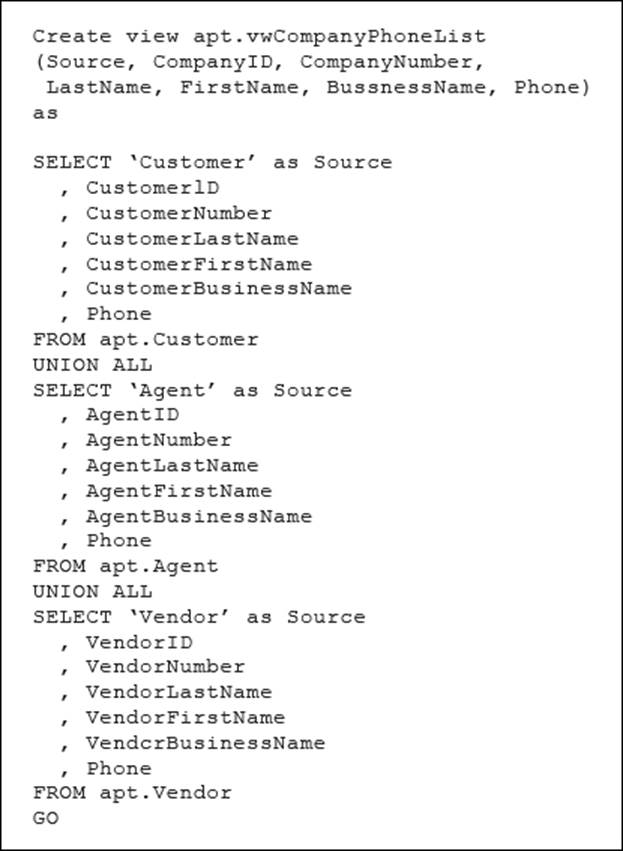
You need to ensure that users can update only the phone numbers by using this view.
What should you do?
- A . Alter the view. Use the EXPAND VIEWS query hint along with each SELECT statement.
- B . Drop the view. Re-create the view by using the SCHEMABINDING clause, and then create an index on the view.
- C . Create an AFTER UPDATE trigger on the view.
- D . Create an INSTEAD OF UPDATE trigger on the view.
You develop a Microsoft SQL Server 2012 database that contains tables named Employee and Person.
The tables have the following definitions:
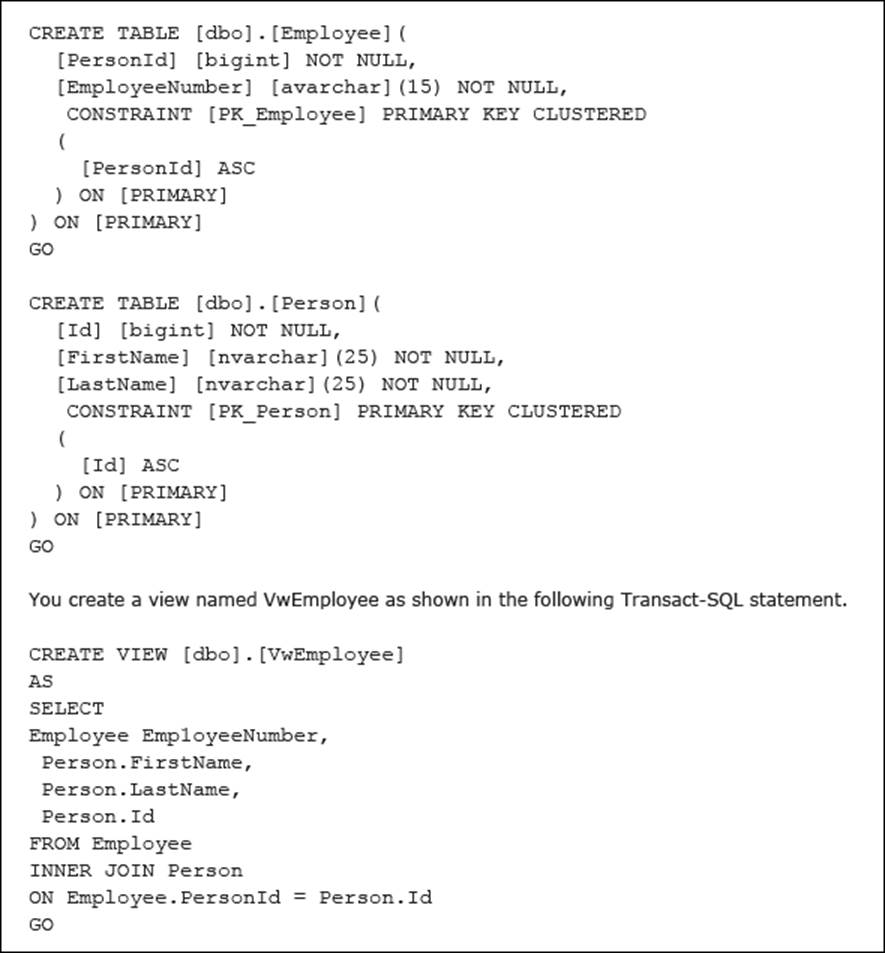
Users are able to use single INSERT statements or INSERT…SELECT statements into this view.
You need to ensure that users are able to use a single statement to insert records into both Employee and Person tables by using the VwEmployee view.
Which Transact-SQL statement should you use?
- A . CREATE TRIGGER TrgVwEmployee
ON VwEmployee
FOR INSERT
AS
BEGIN
INSERT INTO Person(Id, FirstName, LastName)
SELECT Id, FirstName, LastName, FROM inserted
INSERT INTO Employee(PersonId, EmployeeNumber)
SELECT Id, EmployeeNumber FROM inserted
END - B . CREATE TRIGGER TrgVwEmployee
ON VwEmployee
INSTEAD OF INSERT
AS
BEGIN
INSERT INTO Person(Id, FirstName, LastName)
SELECT Id, FirstName, LastName, FROM inserted
INSERT INTO Employee(PersonId, EmployeeNumber)
SELECT Id, EmployeeNumber FROM inserted
END - C . CREATE TRIGGER TrgVwEmployee
ON VwEmployee
INSTEAD OF INSERT
AS
BEGIN
DECLARE @ID INT, @FirstName NVARCHAR(25), @LastName NVARCHAR(25), @PersonID
INT, @EmployeeNumber NVARCHAR(15)
SELECT @ID = ID, @FirstName = FirstName, @LastName = LastName, @EmployeeNumber
= EmployeeNumber
FROM inserted
INSERT INTO Person(Id, FirstName, LastName)
VALUES(@ID, @FirstName, @LastName)
INSERT INTO Employee(PersonID, EmployeeNumber)
VALUES(@PersonID, @EmployeeNumber
End - D . CREATE TRIGGER TrgVwEmployee
ON VwEmployee
INSTEAD OF INSERT
AS
BEGIN
INSERT INTO Person(Id, FirstName, LastName)
SELECT Id, FirstName, LastName FROM VwEmployee
INSERT INTO Employee(PersonID, EmployeeNumber)
SELECT Id, EmployeeNumber FROM VwEmployee
End
You develop a Microsoft SQL Server 2012 database that contains a table named Products.
The Products table has the following definition:
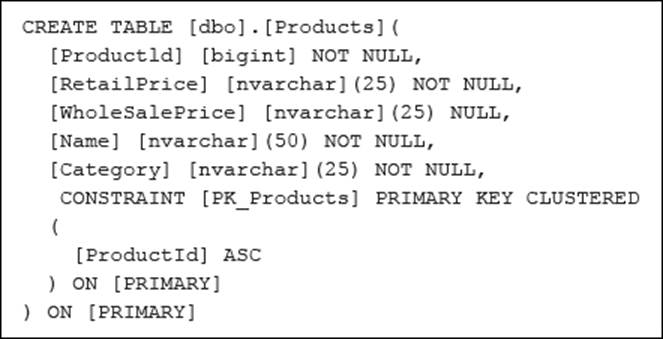
You need to create an audit record only when either the RetailPrice or WholeSalePrice column is updated.
Which Transact-SQL query should you use?
- A . CREATE TRIGGER TrgPriceChange ON Products FOR UPDATE AS
IF CCLUMNS_CHANGED(RetailPrice, WholesalePrice)
– – Create Audit Records - B . CREATE TRIGGER TrgPriceChange ON Products FOR UPDATE AS
IF EXISTS(SELECT RetailPrice from inserted) OR
EXISTS (SELECT WholeSalePnce FROM inserted)
– – Create Audit Records - C . CREATE TRIGGER TrgPriceChange ON Products FOR UPDATE AS
IF COLUMNS_UPDATED(RetailPrice, WholesalePrice)
– – Create Audit Records - D . CREATE TRIGGER TrgPriceChange ON Products FOR UPDATE AS
IF UPDATE(RetailPrice) OR UPDATE(WholeSalePrice)
– – Create Audit Records
A table named Profits stores the total profit made each year within a territory. The Profits table has columns named Territory, Year, and Profit.
You need to create a report that displays the profits made by each territory for each year and its previous year.
Which Transact-SQL query should you use?
- A . SELECT Territory, Year, Profit,
LEAD(Profit, 1, 0) OVER (PARTITION BY Territory ORDER BY Year) AS PrevProfit
FROM Profits - B . SELECT Territory, Year, Profit,
LAG(Profit, 1, 0) OVER (PARTITION BY Year ORDER BY Territory) AS PrevProfit
FROM Profits - C . SELECT Territory, Year, Profit,
LAG(Profit, 1, 0) OVER (PARTITION BY Territory ORDER BY Year) AS PrevProfit
FROM Profits - D . SELECT Territory, Year, Profit,
LEAD(Profit, 1, 0) OVER (PARTITION BY Year ORDER BY Territory) AS PrevProfit
FROM Profits
Latest 70-461 Dumps Valid Version with 232 Q&As
Latest And Valid Q&A | Instant Download | Once Fail, Full Refund

